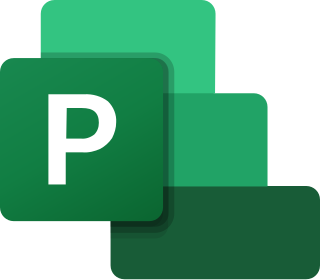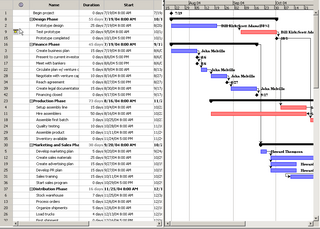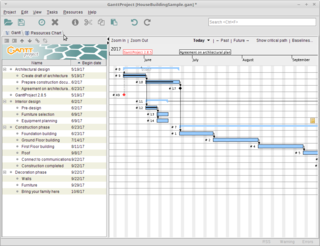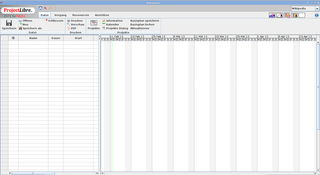Related Research Articles
Active Directory (AD) is a directory service developed by Microsoft for Windows domain networks. It is included in most Windows Server operating systems as a set of processes and services. Initially, Active Directory was only in charge of centralized domain management. However, Active Directory became an umbrella title for a broad range of directory-based identity-related services.

A work-breakdown structure (WBS) in project management and systems engineering, is a deliverable-oriented breakdown of a project into smaller components. A work breakdown structure is a key project deliverable that organizes the team's work into manageable sections. The Project Management Body of Knowledge defines the work-breakdown structure as a "hierarchical decomposition of the total scope of work to be carried out by the project team to accomplish the project objectives and create the required deliverables."
WebDAV is an extension of the Hypertext Transfer Protocol (HTTP) that allows clients to perform remote Web content authoring operations. WebDAV is defined in RFC 4918 by a working group of the Internet Engineering Task Force (IETF).
A software company is a company whose primary products are various forms of software, software technology, distribution, and software product development. They make up the software industry.
The following outline is provided as an overview of and topical guide to software engineering:
Representational state transfer (REST) is a software architectural style that was created to guide the design and development of the architecture for the World Wide Web. REST defines a set of constraints for how the architecture of an Internet-scale distributed hypermedia system, such as the Web, should behave. The REST architectural style emphasises the scalability of interactions between components, uniform interfaces, independent deployment of components, and the creation of a layered architecture to facilitate caching components to reduce user-perceived latency, enforce security, and encapsulate legacy systems. REST has been employed throughout the software industry and is a widely accepted set of guidelines for creating stateless, reliable web services.

Microsoft Project is a project management software product, developed and sold by Microsoft. It is designed to assist a project manager in developing a schedule, assigning resources to tasks, tracking progress, managing the budget, and analyzing workloads.

Microsoft Office Project Server is a project management server solution made by Microsoft since 2000. It uses Microsoft SharePoint as its foundation, and supports interface from either Microsoft Project as a client application or by web browser connecting to its Project Web App (PWA) component.

The architecture of Windows NT, a line of operating systems produced and sold by Microsoft, is a layered design that consists of two main components, user mode and kernel mode. It is a preemptive, reentrant multitasking operating system, which has been designed to work with uniprocessor and symmetrical multiprocessor (SMP)-based computers. To process input/output (I/O) requests, they use packet-driven I/O, which utilizes I/O request packets (IRPs) and asynchronous I/O. Starting with Windows XP, Microsoft began making 64-bit versions of Windows available; before this, there were only 32-bit versions of these operating systems.
Microsoft Transaction Server (MTS) was software that provided services to Component Object Model (COM) software components, to make it easier to create large distributed applications. The major services provided by MTS were automated transaction management, instance management and role-based security. MTS is considered to be the first major software to implement aspect-oriented programming.
Project workforce management is the practice of combining the coordination of all logistic elements of a project through a single software application. This includes planning and tracking of schedules and mileposts, cost and revenue, resource allocation, as well as overall management of these project elements. Efficiency is improved by eliminating manual processes, like spreadsheet tracking to monitor project progress. It also allows for at-a-glance status updates and ideally integrates with existing legacy applications in order to unify ongoing projects, enterprise resource planning (ERP) and broader organizational goals. There are a lot of logistic elements in a project. Different team members are responsible for managing each element and often, the organisation may have a mechanism to manage some logistic areas as well.

OpenProj was an open-source project management software application.

GanttProject is GPL-licensed Java based, project management software that runs under the Microsoft Windows, Linux and Mac OS X operating systems. This project was initiated in January 2003, at University of Marne-la-Vallée (France) and managed, at first, by Alexandre Thomas, now replaced by Dmitry Barashev.
Risk Breakdown Structure (RBS) - A hierarchically organised depiction of the identified project risks arranged by category.
A glossary of terms relating to project management and consulting.
PLANTA Project is a Project management software for the planning and control of projects that share the same resources. PLANTA Project is the successor to the multi-project management system PPMS, which was introduced in 1980. Unlike its predecessor PPMS, PLANTA Project offers process-oriented project management and has a revised workflow-oriented interface, based on the open-source programming language Python, and MS .NET with panel technology which enables users to position windows as required.
The following outline is provided as an overview of and topical guide to project management:

ProjectLibre is a project management software company with both a free open-source desktop and an upcoming Cloud version.

Distributed Data Management Architecture (DDM) is IBM's open, published software architecture for creating, managing and accessing data on a remote computer. DDM was initially designed to support record-oriented files; it was extended to support hierarchical directories, stream-oriented files, queues, and system command processing; it was further extended to be the base of IBM's Distributed Relational Database Architecture (DRDA); and finally, it was extended to support data description and conversion. Defined in the period from 1980 to 1993, DDM specifies necessary components, messages, and protocols, all based on the principles of object-orientation. DDM is not, in itself, a piece of software; the implementation of DDM takes the form of client and server products. As an open architecture, products can implement subsets of DDM architecture and products can extend DDM to meet additional requirements. Taken together, DDM products implement a distributed file system.
A human resources management system (HRMS) or human resources information system (HRIS) or human capital management (HCM) is a form of human resources (HR) software that combines a number of systems and processes to ensure the easy management of human resources, business processes and data. Human resources software is used by businesses to combine a number of necessary HR functions, such as storing employee data, managing payroll, recruitment, benefits administration, time and attendance, employee performance management, and tracking competency and training records.
References
- ↑ Project Management Body of Knowledge (PMBOK Guide) – Fourth Edition, page 145. Project Management Institute, 2008.
- ↑ Rad, Parviz F. Project Estimating and Cost Management, page 33. Management Concepts, 2001.
- ↑ Define Resource Breakdown Structure, Project Team Blog, posted June 26,2012, http://www.projectteamblog.com/index.php/define-resource-breakdown-structure-rbs/
- ↑ RBS Fields, Microsoft Office Support page, https://support.office.com/en-au/article/RBS-fields-5d08f8c1-be86-4ea7-b93e-27ba5112427b (retrieved 3/13/2015)